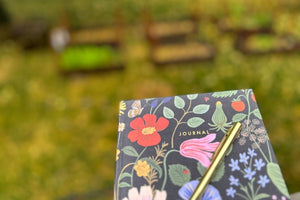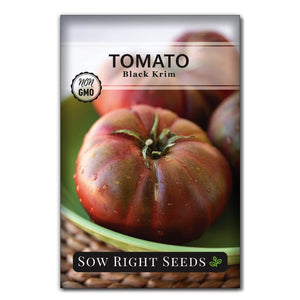How to Start Tomatoes from Seed – The FAQs Every Gardener Asks
TomatoesNew gardeners often feel daunted by the idea of starting tomatoes from seed, but it’s not as hard as you think! Starting your tomatoes at home is the perfect way to enjoy the fun of gardening while you’re waiting for the weather to warm up. And, with our tips and tricks for beginners, you will avoid common mistakes beginners often face.

Tomato Seed Starting Questions - Quick Links
Starting Tomatoes from Seed
There are many reasons to start tomatoes from seed rather than buying transplants from your local garden center. Our favorite reason is we can grow more varieties of tomatoes!
Only a few types of tomatoes are available as plants, and most of those are hybrids. You can grow a broader range of colors and flavors by starting tomatoes from heirloom seeds.
You will want to purchase quality seeds with reliable germination. Sow Right Seeds heirloom tomatoes will give you great results when you follow these tomato seed starting tips.
What do my seeds need for proper germination?
Containers & Soil
The first step in starting your tomatoes from seed is pathogen prevention. This means using sterilized pots or trays, as well as a sterile growing medium.
-
If you're reusing pots from previous years, a soak in a 10% solution of household bleach for 30 minutes will be enough.
-
A soilless medium works well for germination. You can use potting mix or create your own seed starting mix with our favorite recipe.
-
Press the seeds into the growing medium until they are buried very shallowly - about ¼”.
You might be tempted to add some fertilizer to your growing medium. Don't. The fertilizing salts could prevent or slow germination, so be patient. You'll get there!

What about warmth & light?
Tomatoes do not require light to germinate, but keeping them consistently warm is helpful.
A germination temperature of 70-80°F is best for optimal germination. A heat mat underneath your pots or seed trays is the perfect way to keep a consistent temperature.
Mist your seeds to keep them moist but not wet. A humidity dome will help you to retain this needed moisture. Keep the dome on until the seeds begin to sprout, usually in 7-14 days.

My tomato seeds sprouted! What's next?
After germination, you can take off the humidity dome to avoid any damping off. You will also want to water from the bottom to encourage root growth and keep the soil moist but not waterlogged.
Now you can also fertilize. We told you it wouldn't take long!
Water with a half dose of fertilizer the first week and gradually move up to full strength afterward.
You'll also need to provide strong lights for your tomato seedlings. Oftentimes, a sunny window does not provide enough light. Fluorescent shop lights or grow lights will ensure you have bright light.
The seedlings need to be quite close to the lights. A grow light should be placed just a few inches away. This will prevent leggy seedlings. When seedlings have to stretch for the light, their stems are thin and easily fall over.

When should I pot up my tomato seedlings?
Your tomatoes will soon develop their first true leaves. These look a little different than the cotyledons or seed leaves that first emerge. True leaves have the appearance of a mature tomato plant's leaves.
Once there are four true leaves, it's time to pot your tomato plants up. Potting up means transplanting your tomato seedlings into larger containers. Each time you pot up, bury the tomato plant up to its lowest leaves. The stem that is now underground will develop roots. This larger root stem will develop a stronger root system for healthy tomato plants.
At this point, you can use potting soil. This type of garden soil will have the nutrients needed for healthy plant growth.
This is also a good time to thin your seedlings. You will keep the healthiest seedlings and cut out the rest. It sounds brutal, but this will ensure one strong and healthy tomato plant per pot without roots competing for nutrients.

How do I prepare my tomato plants for transplanting into the garden?
The last step before your tomatoes move completely outside is hardening off.
This period of adjustment is essential for your plants to get used to the conditions outdoors. Harden off your tomato seedlings gradually, over a week or two. Choose a mild day and shield your plants from wind and harsh sun. Start with one hour and gradually increase the amount of time exposed to outdoor conditions while decreasing the protection. This gradual transition will prevent transplant shock.

My tomato plants are ready for the garden. Now what?
One last word of advice: don't rush the process because you're getting so excited about your tomatoes!
Temperatures over 60°F are important for proper growth and healthy tomatoes. Wait to transplant your tomato seedlings into the garden until after the average last spring frost date. You want to ensure all chance of frost is past. Be patient so that all of your hard work pays off.
Also, be prepared to protect your seedlings with row covers or plant covers (or even a blanket!) if a late frost threatens.

Before you know it, you'll be harvesting juicy, delicious tomatoes in eight weeks or less. And you’ll be happy knowing you grew yourself!
No matter what tomato varieties you grow, from cherry tomatoes to huge beefsteak, these tips will get you started.
For more information on growing tomatoes, check out our Planter's Library. You'll find specific information on fertilizing, pruning, companion planting, and more.
Written by Teresa Chandler
If you found these tomato seed starting tips helpful, share them with your gardening friends.









Our favorite seed-starting containers are cell packs in trays. They have 4 cells or 6. They are about 3" deep and 2" wide. You can see them in the pictures above. You should be able to find lots of options online or at your local garden store.
Hi John. I seen your comment with no comments so I figured I would give you my personal advice/preference. Instead of starting my seeds in a tiny little container and replanting, I start mine in 3 × 1.5 composite pots. I get mine on Amazon. Here is a good link for a starter kit (P.S. I am in no way associated with this product. I just like it and use it). https://www.amazon.com/gp/product/B09LXZQPFJ/ref=ppx_yo_dt_b_asin_title_o00_s00?ie=UTF8&psc=1
Good Luck!
What size containers should I use to start tomatoes seeds in. Do you know a link I could go to ?
Thank you, John
Leave a comment